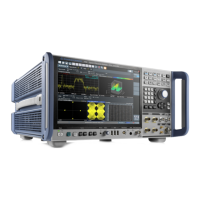Common Analysis and Display Functions
R&S
®
FSW
576User Manual 1173.9411.02 ─ 43
Example:
Assume the following measurement parameters:
●
Sample rate: 32 MSamples / s
●
sweep points: 1000
●
sweep time: 100 ms
●
Span: 5 GHz
During a single sweep, 3.2 * 10
6
samples are collected and distributed to 1000 sweep
points, i.e. 3200 samples are collected per sweep point. For each sweep point, the
measured data for a frequency span of 5 MHz (span/<sweep points>) is analyzed.
Note that if you increase the number of sweep points, the frequency span analyzed for
each point in the trace decreases, making the result more stable.
See also Chapter 8.5.1.8, "How Much Data is Measured: Sweep Points and Sweep
Count", on page 464.
Obviously, a data reduction must be performed to determine which of the samples are
displayed for each sweep point. This is the trace detector's task.
The trace detector can analyze the measured data using various methods:
The detector activated for the specific trace is indicated in the corresponding trace
information by an abbreviation.
Table 9-3: Detector types
Detector Abbrev. Description
Positive Peak Pk Determines the largest of all positive peak values of the levels measured at the
individual frequencies which are displayed in one sample point
Negative Peak Mi Determines the smallest of all negative peak values of the levels measured at
the individual frequencies which are displayed in one sample point
Auto Peak Ap Combines the peak detectors; determines the maximum and the minimum
value of the levels measured at the individual frequencies which are displayed
in one sample point
(not available for SEM)
RMS Rm Calculates the root mean square of all samples contained in a sweep point.
To do so, R&S FSW uses the linear voltage after envelope detection. The sam-
pled linear values are squared, summed and the sum is divided by the number
of samples (= root mean square). For logarithmic display, the logarithm is
formed from the square sum. For linear display, the root mean square value is
displayed. Each sweep point thus corresponds to the power of the measured
values summed up in the sweep point.
The RMS detector supplies the power of the signal irrespective of the wave-
form (CW carrier, modulated carrier, white noise or impulsive signal). Correc-
tion factors as needed for other detectors to measure the power of the different
signal classes are not required.
Trace Configuration

